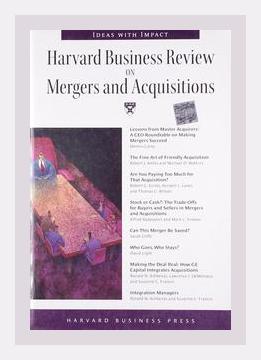Business StrategyMergers and Acquisitions
Harvard Business Review on Mergers and Acquisitions – Summary
Introduction
“Harvard Business Review on Mergers and Acquisitions” (2001) offers a comprehensive examination of the multifaceted process of mergers and acquisitions (M&A). The book compiles articles by industry experts and thought leaders, each contributing key insights and actions to help executives navigate and succeed in the complex world of M&A.
1. Understanding the Strategic Landscape
Key Points:
– Mergers and acquisitions should be strategically driven, not opportunistic.
– Understanding macroeconomic factors and industry trends is crucial.
Example:
– The book discusses how General Electric (GE) made successful acquisitions that aligned with their long-term vision of becoming a diverse industrial conglomerate.
Actionable Advice:
– Action: Conduct a thorough market analysis and competitive assessment before considering any acquisition. This includes analyzing market growth rates, technological changes, regulation, and buyer and seller power.
2. Identifying Potential Targets
Key Points:
– The right target must fulfill strategic goals, complement existing capabilities, and offer synergies.
– Evaluating a company’s culture and values is as important as financial metrics.
Example:
– The acquisition of Pixar by Disney is emphasized as an example where cultural fit played a pivotal role in the success of the merger.
Actionable Advice:
– Action: Create a checklist for potential targets that includes financial health, market position, culture compatibility, and synergy potential. Engage cross-functional teams to provide diverse perspectives on target identification.
3. Due Diligence: Beyond Financials
Key Points:
– Due diligence must extend beyond financial audits to include operational, cultural, and strategic assessments.
– Evaluating management teams and technological capabilities can prevent future integration issues.
Example:
– The Daimler-Chrysler merger presents a cautionary tale of inadequate due diligence in cultural compatibility leading to integration challenges.
Actionable Advice:
– Action: Develop a comprehensive due diligence framework encompassing financial, operational, cultural, legal, and IT aspects. Assign specialists for each area to ensure an in-depth analysis.
4. Valuation and Pricing
Key Points:
– Accurate valuation models must be utilized, including discounted cash flow (DCF), comparable company analysis, and precedent transactions.
– Understand the risks and growth potential to determine a fair price.
Example:
– The book references Warren Buffett’s approach to valuation, emphasizing intrinsic value and long-term potential rather than short-term gains.
Actionable Advice:
– Action: Perform multiple valuation methods and compare the outcomes to ensure robust price determination. Include scenario analyses to account for different market conditions and future uncertainties.
5. Negotiation Techniques
Key Points:
– Negotiation should aim for a win-win situation rather than a zero-sum game.
– Building trust and maintaining transparency throughout the negotiation process is critical.
Example:
– The merger between Vodafone and Mannesmann is highlighted for its complex negotiation process, ultimately leading to one of the largest telecom deals.
Actionable Advice:
– Action: Develop a negotiation strategy that prioritizes clear communication, mutual benefits, and flexibility. Invest time in understanding the other party’s motivations and constraints.
6. Integration Planning
Key Points:
– Integration is often the most challenging phase of M&A and requires meticulous planning and execution.
– Focus on quick wins and long-term integration simultaneously.
Example:
– The integration of Bank of America and Merrill Lynch is noted for its detailed integration plans, addressing both cultural and operational integration from the onset.
Actionable Advice:
– Action: Form an integration team early in the process, led by top executives from both companies, to oversee integration activities. Develop an integration playbook addressing key areas such as HR, IT, operations, and culture.
7. Managing Cultural Differences
Key Points:
– Cultural integration can significantly affect the success of a merger.
– Understanding and blending the distinct cultures of merging organizations is essential.
Example:
– The successful merger of Glaxo Wellcome and SmithKline Beecham is attributed to extensive efforts in aligning cultures and values.
Actionable Advice:
– Action: Conduct cultural assessments and workshops to identify similarities and differences. Develop a unified cultural vision and communication plan to facilitate cultural blending.
8. Post-Merger Value Creation
Key Points:
– Realizing the expected synergies and ensuring ongoing value creation is key to long-term success.
– Continuous monitoring and flexibility in strategy execution often determine the merger’s eventual success.
Example:
– The successful integration of Exxon and Mobil, where rigorous performance tracking and synergy realization contributed to sustained value creation.
Actionable Advice:
– Action: Establish post-merger performance metrics and regular review meetings to track progress against synergy targets. Be open to making strategic adjustments based on post-merger performance data.
Conclusion
“Harvard Business Review on Mergers and Acquisitions” serves as a vital guide, emphasizing the importance of strategic alignment, thorough due diligence, and meticulous integration planning. By learning from both successful and unsuccessful mergers, executives can develop more refined strategies to navigate the complex M&A landscape effectively.
Implementation Strategy
- Strategic Analysis and Target Identification:
-
Action: Conduct regular strategic reviews and market analyses. Establish a team dedicated to identifying and evaluating potential M&A targets.
-
Enhanced Due Diligence:
-
Action: Develop a multi-disciplinary due diligence framework. Train team members in comprehensive due diligence practices that include culture and management assessments.
-
Valuation and Negotiation Preparation:
-
Action: Utilize advanced financial models for valuation. Prepare a detailed negotiation plan, emphasizing transparency and mutual benefits.
-
Integration and Cultural Blend:
-
Action: Form a cross-functional integration team early. Conduct regular cultural assessments and develop unifying values and goals.
-
Post-Merger Value Tracking:
- Action: Set up a post-merger integration office (PMI) to track performance and ensure synergy realization. Establish KPIs and regular checkpoints.
By following these structured approaches, businesses can enhance their M&A processes and increase the likelihood of successful outcomes.
This summary captures the essential ideas and practical recommendations from “Harvard Business Review on Mergers and Acquisitions.” The book is invaluable for professionals seeking to deepen their understanding of M&A strategies and operations.
